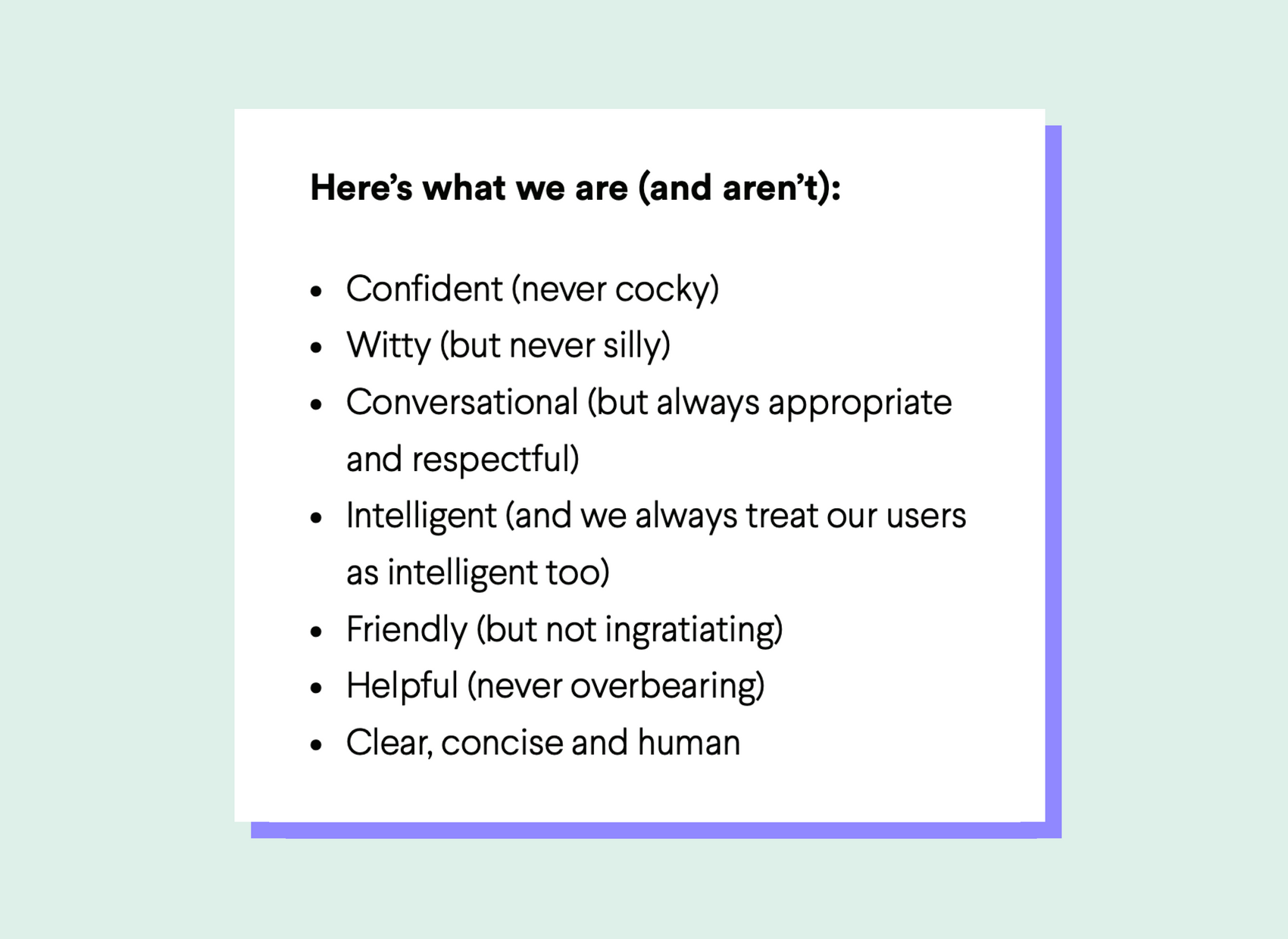
How To Find Your Brand Voice: The 6-Step Guide
A distinctive brand voice helps build brand recognition. This six-step guide will help you define and develop a consistent voice for your company.
When companies first start investing in their brand, they focus on visual elements like logos, color palettes, and typography. Brand voice is often an afterthought. But as your teams create content for the company, your brand voice emerges organically. Unfortunately, it’s indistinct and inconsistent because you never defined it in the same way as your visual brand elements.
But a distinct brand voice is just as important as your logo and imagery. It’s a big part of how you express and communicate your brand identity, which helps to build brand recognition. So companies are increasingly including brand voice and tone in their brand guidelines, as they understand how voice helps build brand recognition. For example, Slack says, “Our voice isn’t just an intrinsic part of the product, it’s an external representation of the people behind it.”
To help you develop a distinct brand voice, we’ve put together a six-step guide. This covers how to define and document your brand voice, so your team can adopt it consistently.
1. Review Your Existing Content
Reviewing your content will help you understand your company’s existing voice and tone – the one that emerged through necessity rather than design. Once you understand the voice used in your existing company comms, you can refine it and turn it into a deliberate, authentic representation of your brand identity.
To review your existing brand voice, start by collecting a comprehensive sample of your existing content, including:
- Content from multiple channels – your website, social media, newsletters, and press releases
- Content produced by each department – sales, product, engineering, marketing, support, and leadership
- Content in different formats – long-form, short, video, audio, and written
- Customer-facing and internal content
For each piece of content, rank it based on how well it communicates the main characteristics of your brand identity. Then score each piece on how authentic it feels for your brand. Finally, make notes on what does (and doesn’t) feel right in each piece of content. Any details you can pick out will help you better understand the different elements of your brand voice, which will help you define it for the rest of your team.
2. Identify Your Unique Brand Characteristics
Your brand voice helps you communicate your brand identity in written, video, or audio content. To define and develop a consistent tone of voice for your brand, start by looking at the main characteristics of your brand. These characteristics will influence the tone, style, and personality of your brand voice.
To identify the primary characteristics of your brand, review your company or brand values and your company’s mission statement (if you have one). These characteristics will help you develop a brand voice that feels authentic to your company, as it’s rooted in your existing values and brand identity.
Look for the adjectives that repeatedly appear – the words used most often to describe your company and brand. For example, Slack’s brand voice is confident, intelligent, and helpful:

Make a list of these words so you can refer back to them later. These characteristics are the starting point for defining your voice, as it needs to be an authentic representation of your brand’s personality and identity.
3. Define How Your Tone Changes Across Channels & Content Types
Once you’ve identified your brand voice characteristics, you should clarify how your tone will adapt to different purposes.
Start by listing out all the different marketing channels you use and the types of content your team creates. Your brand’s tone of voice will change to suit each channel and content type. Your list should include content produced by all departments, not just marketing, as all teams contribute to your brand’s reputation.
Next, identify the target audience for each content type or channel on your list. Then work out how your communication style should change to best appeal to that target audience.
The University of Dundee includes several examples of tone of voice in its content style guide. It lists out different types of content, the intended audience, the tone of voice, and a snippet of example copy to help the reader understand the difference between each example:

If you’re unsure how your brand voice should change, consider how your own voice adapts depending on the context and whom you’re speaking to. For example, you don’t use the same tone of voice on the phone to your bank, in an end-of-year review meeting with your boss, and at dinner with friends.
4. Listen to Your Customers
Your brand voice should resonate with your customers so that you can connect with them and build rapport through all your customer communications. To refine your brand voice even further, listen to customer calls and see how you can bring elements of their communication style into your company’s voice and tone.
For example, on sales calls, pay attention to how customers talk about your products and how they describe the problem you’re solving for them. Make a note of any words and phrases they frequently use to describe your products or brand. Then, use these phrases to develop a list of words to use or avoid in your content.
Mailchimp includes a word list in its brand guidelines, including words to use carefully (that could feel like jargon if used in the wrong context) and avoid because they don’t align with its brand identity.

Developing a word list might feel incredibly granular, but getting specific about the words and phrases you use will help to differentiate your brand voice from other companies. A list of words to use and avoid helps develop a consistent language for your brand. This shared language will help create a consistent brand voice across different channels and departments.
And by bringing in words and phrases your customers use, you can create a sense of familiarity with your target audience and a rapport that comes with feeling like you’re speaking the same language.
5. Document Your Findings in Brand Voice Guidelines
Once you’ve identified the different elements that make up your brand voice – from broad brand characteristics to specific words to use or avoid – you should document your findings. Writing down all the elements that make up your brand voice helps turn it from some loose ideas and preferences into a formalized voice for your brand. It also helps standardize your company’s voice across all departments because you can provide guidelines and examples for everyone to follow.
You want to make it as easy as possible for everyone in your team (plus agencies, partners, and freelancers) to access and use your brand guidelines. Many of our customers used to document their brand guidelines in PDFs but find that using Frontify’s digital Brand Guidelines platform makes it easier to share, update, and collaborate on their guidelines.
But whatever format you use for your brand voice guidelines, make sure you include all the important elements of your brand voice, including:
- Guidelines for different types of content
- Guidelines for different channels
- Guidelines for everyday words and phrases
- Your lists of words to use and words to avoid
Where possible, include practical examples in your brand voice guidelines. These will help your team put the guidelines into practice when creating their own content.
6. Review Your Brand Voice (at Least) Once a Year
Your brand voice will evolve over time. You should review it regularly to ensure it still feels like an authentic expression of your brand identity.
Review company content across different channels, formats, departments, and content published at different times of the year. Look at what’s consistent and in keeping with your guidelines – and where inconsistencies have crept in. For example, some discrepancies may be down to team members not following your voice and tone guidelines. But some may feel authentic to your brand, in which case you should update your brand guidelines to recognize this change to your brand voice.
Help Your Team Achieve Brand Consistency
To achieve brand consistency, you need everyone on your team to adopt your brand voice – not just the marketing department or half the sales team. Help them do so by providing clear guidelines and running training sessions so everyone understands how your tone of voice changes across different channels and content types.
